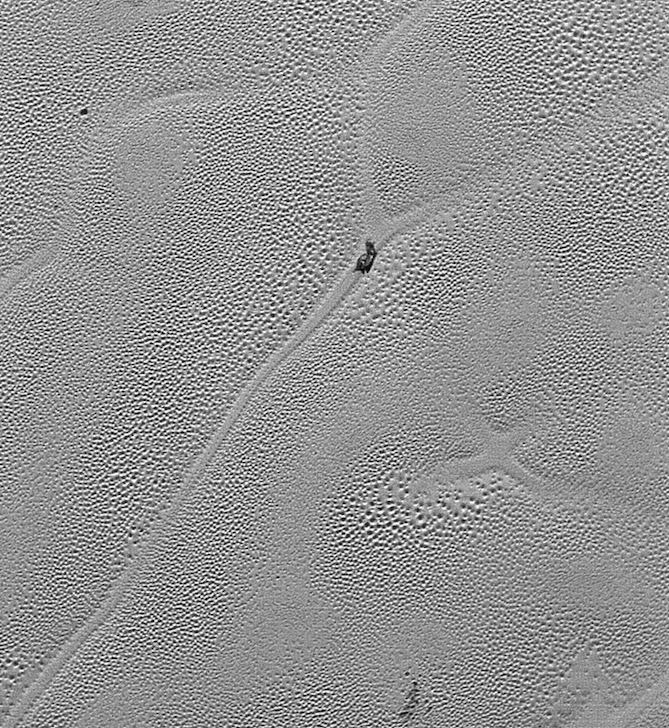On Pluto, 'X' Marks the Spot (Photo)

There's a big "X" on Pluto, and it marks buried treasure of a scientific kind.
The X-shaped feature, on the huge Pluto nitrogen-ice plain known as Sputnik Planum, is visible in photos recently beamed home by NASA's New Horizons probe, which performed history's first-ever flyby of the dwarf planet on July 14, 2015.
Sputnik Planum's surface is composed of many polygonal ice blocks that are between 10 miles (16 kilometers) and 25 miles (40 km) wide. These blocks were likely formed by thermal convection processes on Pluto, New Horizons scientists say: Solid nitrogen deep beneath the surface is warmed by Pluto's mysterious interior heat, rises in huge globs, and then cools and sinks again. [See more photos of Pluto and its moons]
"This part of Pluto is acting like a lava lamp, if you can imagine a lava lamp as wide as, and even deeper than, the Hudson Bay," William McKinnon of Washington University in St. Louis, the deputy leader of New Horizons' Geology, Geophysics and Imaging team, said in statement.
The Sputnik Planum X probably marks a spot where four convection cells once met, mission scientists said. The dark patch to the X's upper left, meanwhile, is likely a dirty chunk of water ice floating atop the sea of nitrogen ice.
The photo depicting the X is one of a series of high-resolution shots New Horizons captured of Sputnik Planum with its telescopic camera from a distance of 10,000 miles (16,000 km) on July 14, about 15 minutes before the probe's closest approach (which took it within 7,800 miles, or 12,550 km, of the dwarf planet's surface).
The pictures combine to cover a swath of Sputnik Planum 50 miles (80 km) wide and more than 400 miles (640 km) long. The images boast a resolution of 250 feet to 280 feet (77 m to 85 m) per pixel, resolving surface features as small as half a city block, NASA officials said.
Breaking space news, the latest updates on rocket launches, skywatching events and more!
New Horizons beamed these photos back to Earth on Dec. 24, and NASA released them on Thursday (Jan. 7).
While the spacecraft relayed some of its flyby data and images home shortly after the July close encounter, most were stored on board for later transmission. To date, mission control has received just 25 percent of so of the flyby dataset. However, most of the highest-resolution Pluto images (including the newly released Sputnik Planum set) have now been received. Everything should be down on the ground by October or November, mission team members have said.
New Horizons is currently cruising toward a small object called 2014 MU69, which lies about 1 billion miles (1.6 billion km) beyond Pluto. The probe will perform a flyby of 2014 MU69 on Jan. 1, 2019, if NASA approves a proposed extended mission.
Follow Mike Wall on Twitter @michaeldwall and Google+. Follow us @Spacedotcom, Facebook or Google+. Originally published on Space.com.

Michael Wall is a Senior Space Writer with Space.com and joined the team in 2010. He primarily covers exoplanets, spaceflight and military space, but has been known to dabble in the space art beat. His book about the search for alien life, "Out There," was published on Nov. 13, 2018. Before becoming a science writer, Michael worked as a herpetologist and wildlife biologist. He has a Ph.D. in evolutionary biology from the University of Sydney, Australia, a bachelor's degree from the University of Arizona, and a graduate certificate in science writing from the University of California, Santa Cruz. To find out what his latest project is, you can follow Michael on Twitter.

